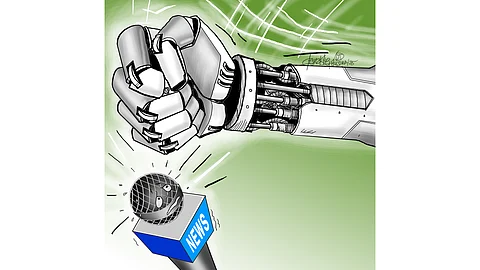
- NEWS
- the EDIT
- COMMENTARY
- BUSINESS
- LIFE
- SHOW
- ACTION
- GLOBAL GOALS
- SNAPS
- DYARYO TIRADA
- MORE

World Press Freedom Day quietly passed last Sunday, with little of the attention it deserves, even as the freedom it seeks to protect comes under increasing threat.
In an age when artificial intelligence (AI) is revolutionizing how we produce, distribute, and consume information, authoritarian states are exploiting these very tools to suppress press freedom.
As noted by the UN High Commissioner for Human Rights, governments across the globe are now using AI to monitor journalists and their sources — violating privacy, undermining trust, and sending a chilling message to media workers: You are being watched.
This growing surveillance trend is not just a technological issue — it is a political and moral one.
AI-powered facial recognition, location tracking, predictive analytics, and even deep fake technologies are being deployed by state actors to identify journalists’ contacts, infiltrate newsrooms and trace leaks.
These tools, once hailed for their potential to automate newsroom tasks and uncover patterns in massive data sets, are now increasingly being weaponized. For journalists covering corruption, war, human rights abuses, and organized crime, such surveillance doesn’t just hinder their reporting; it can endanger their lives.
The implications are vast. A journalist’s ability to protect his sources is foundational to investigative reporting. Whistleblowers and insiders, who often risk everything to reveal the truth, rely on anonymity.
When governments can use AI to pierce that veil of confidentiality, fewer people will come forward, and fewer truths will surface. What we are seeing is not merely a repression of the press, but a deliberate attempt to control the narrative by scaring journalists into silence and turning potential sources into hostages of fear.
Meanwhile, AI is radically reshaping the media landscape in other ways. Newsrooms are automating content generation — from financial reports to sports summaries — while AI curates personalized newsfeeds for audiences across the globe.
Social media algorithms prioritize engagement over accuracy, allowing misinformation to spread faster than fact-checked journalism. Deepfake videos and AI-generated text blur the line between truth and fabrication, making it harder for citizens to distinguish real reporting from propaganda or manipulation.
This duality — AI as both a tool of empowerment and oppression — sits at the heart of today’s press freedom dilemma. While journalists can harness AI to process large data sets, uncover patterns, and produce content faster, they must now also grapple with the reality that their own tools may be used against them.
This irony is not lost on the media community, which finds itself racing to catch up with technological advancements while governments and powerful corporations sprint ahead with little oversight.
What World Press Freedom Day reminds us — especially in this new AI-driven era — is that the right to free expression, to report and be informed, cannot be taken for granted.
We must urgently rethink how to protect journalists in the digital age, ensuring that technological progress doesn’t come at the cost of democratic values. Legal safeguards, digital security protocols, and international cooperation are necessary to defend a free press against AI-driven repression.
The decline of press freedom in the shadows of AI surveillance is not just a media problem — it is a societal one. When journalists are silenced, entire societies are blinded.
The fight for truth is increasingly fought not only with pens and microphones but against invisible algorithms and the surveillance code. And that makes the role of journalists — and the need to protect them — more vital than ever.
